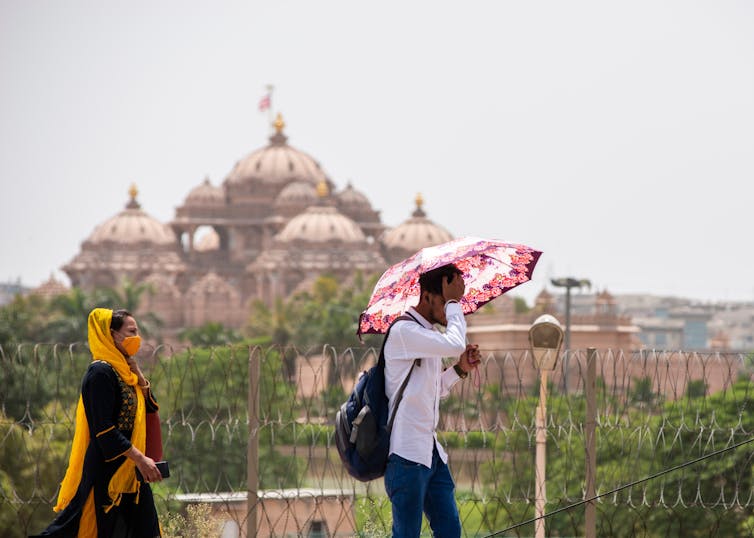Before you read, remember this: Independent editorial isn’t free. If you enjoy this article, please consider creating an account to support our journalism so we can keep going.
After 2022 was designated the hottest in 122 years, extreme heat has appeared early again this year with over 60% of India recording above-normal maximum temperatures for April, according to the country’s Meteorological Department. El Niño, a natural climate event that can increase global temperatures, is also expected to occur this year.
The increasing frequency of such deadly heatwaves could halt or even reverse India’s progress in reducing poverty, food and income security and gender equality, harming the quality of life for over 1.4 billion Indians.
As a natural phenomenon, extreme heat is projected to occur once every 30 years or so in the Indian subcontinent. This is no longer the case thanks to man-made climate change. India has suffered over 24,000 heatwave-related deaths since 1992 alone, with the May 1998 heatwave being one of the most devastating as it claimed over 3,058 lives.
During the May 2010 heatwaves, temperatures in the western city of Ahmedabad reached 47.8°C and raised heat-related hospital admissions of newborns by 43%, prompting the city to become one of the country’s first to implement a heat action plan meant to guide preparations and emergency responses to heatwaves which has since saved thousands of lives. The 2015 heatwave killed over 2,330 people and prompted the government ministry for disaster management to set guidelines for preventing deaths during heatwaves and push Indian states to develop their own plans.

Sudarshan Jha/Shutterstock
Failure to implement these strategies may stymie India’s economic progress. If proper heat action plans are not developed, excessive heat could cost India 2.8% and 8.7% of its GDP by 2050 and 2100, respectively. This is a worrying trend, especially given India’s goal of becoming a 10-trillion-dollar economy by 2030.
A ‘real-feel’ measure
Heat action plans are only useful if they can represent the consequences of heatwaves over the entire population. For Indian authorities to recognise when deadly heat is present (and emergency action is needed), the government has to know how conditions feel for the public.
We used an environmental health measure popular in the US called the heat index to determine how hot the human body is likely to feel in relation to air temperature and humidity levels. This helped us to map how sensitive people were to heatwaves across India and discover that 90% of the country was in danger of severe repercussions during last year’s heatwave.
It’s important to accurately measure India’s vulnerability to lethal temperatures. The metric used by the Indian government, known as the climate vulnerability index, does not account for the physical dangers of heat to human health. Our research showed that combining air temperature and relative humidity levels gave our heat index a “real-feel” measure for extreme heat. In other words, how extreme heat felt for people experiencing it.
Stop underestimating heatwaves
Underestimating the effects of extreme heat in India could reduce or even reverse its progress on a range of goals for sustainable development. These include those related to poverty, hunger, health and wellbeing, equality, economic growth and industrial innovation and biodiversity. This is especially concerning given that India’s progress towards achieving these goals has slowed over the last 20 years while the number of extreme weather events has increased.
Extreme heat, for example, can exacerbate drought by drying up the soil and disrupting rainfall patterns, ultimately blighting crop production and food security, which endangers the health and wellbeing of a large portion of Indian society. Being a primarily agricultural economy, productivity losses in this sector threaten the jobs and health of millions of marginal and small landholding farmers, as well as their ability to adapt and take up new livelihoods. Another worrying tendency with heatwaves is increasing water-borne and insect-borne diseases, which could further strain India’s already beleaguered public health system.
Every year, millions of people from rural areas migrate to India’s cities in search of a better quality of life. But heatwaves have a disastrous effect on the country’s urban population too. Practically the entire city of Delhi and its 32 million inhabitants were threatened by the 2022 heatwaves. Most migrants are forced to settle in the city’s poorest quarters, where the effects of heatwaves are particularly catastrophic. Sadly, these communities also lack the means to buy air conditioners that might ease their misery.

PradeepGaurs/Shutterstock
Present procedures for assessing the sensitivity of India to climate change will not help people resist the exceptional heat seen in recent years and must be upgraded immediately.
The Intergovernmental Panel on Climate Change estimates that heatwaves in South Asia will grow more powerful and frequent this century. Heat action plans will be crucial in speeding up efforts to mitigate and adapt to the effects, but they must represent the complexity of India’s vulnerabilities to climate change. The emphasis on making Indian cities resilient to extreme heat is critical, since cities will see a population explosion in the next ten years, with 70% of Indian building stock yet to be created. There is a chance to incorporate methods for adapting to extreme heat by designing new homes that are easier to keep cool.
With many more people in India expected to be hit by even greater heat extremes in the future, finance, urban design and education are necessary to help people adapt.
Cover Photo: PradeepGaurs/Shutterstock



